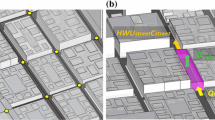The experience gained in validating calculations of the ground-surface concentration of a pollutant injected into an urban environment from a stationary high-altitude source is presented. A Gaussian model using the average annual emission, the characteristic parameters of the source, and a real annual wind rose, as well as a Lagrangian-type model, in which the input parameters were the average daily emission and hourly meteorological parameters, are examined. The computational results were compared with the measured values of the concentration of 131I. It is shown that when using average annual data the uncertainty of the estimates at a particular point located 4–6 km from the source сan reach 4-fold. For emissions which are not protracted (up to one day), even given a full-fledge set of data on the meteorological parameters, the uncertainty of the estimated average daily concentration at the same point can reach one order of magnitude.
Similar content being viewed by others
References
G. G. Onishchenko, S. M. Novikov, Yu. A. Rakhmanin, et al., Fundamentals of the Assessment Risks to Public Health from Chemicals Polluting the Environment, Yu. A. Rachmanin and G. G. Onishchenko (eds.), NII ECH and GOS, Moscow (2002).
S. V. Panchenko, At the Sources of Radioecology, Preprint IBRAE-2018-02 (2018).
A. A. Arakelyan, M. V. Vedernikova, A. A. Kiselev, et al., “Analysis of health risks for the population of Obninsk from the impact of emissions of harmful substances into the atmosphere,” Probl. Analiza Riska, 15, No. 5, 26–37 (2018).
The Radiation Situation on the Territory of Russia and Neighboring States in 2014, 2015, 2016, 2017. Yearbook of RPA Typhoon, Obninsk (2015, 2016, 2017, 2018).
Report on Environmental Safety for 2014, Affiliate of Karpov NIFKhI, Rosatom (2015).
N. G. Gusev and V. A. Belyaev, Radioactive Emissions in the Biosphere, Energoatomizdat, Moscow (1991), 2nd ed.
F. Gifford, “Atmospheric dispersion calculations using the generalized Gaussian plume model,” Nucl. Saf., 2, 56 (1960).
N. L. Byzova, E. K. Garner, and V. N. Ivanov, Experimental Studies of Atmospheric Diffusion and Calculation of Impurity Propagation, Gidrometeoizdat, Leningrad (1991).
R. V. Arutyunyan, D. A. Pripachkin, V. N. Semenov, et al., Description of a System for Predicting the Accidental Dispersal of Radionuclides in the Atmosphere for Operating Russian Nuclear Power Plants (PARRAD). Technology and Operation, IBRAE Preprint–2016-02.
Author information
Authors and Affiliations
Corresponding author
Additional information
Translated from Atomnaya Énergiya, Vol. 128, No. 5, pp. 282–288, May, 2020.
Rights and permissions
About this article
Cite this article
Panchenko, S.V., Pripachkin, D.A., Kryshev, A.I. et al. Experience in using Models of Pollutant Dispersal in an Urban Environment. At Energy 128, 305–311 (2020). https://doi.org/10.1007/s10512-020-00692-6
Received:
Published:
Issue Date:
DOI: https://doi.org/10.1007/s10512-020-00692-6




